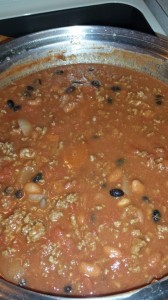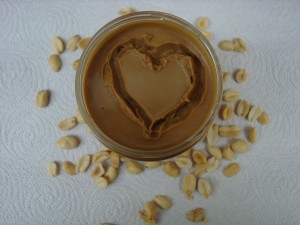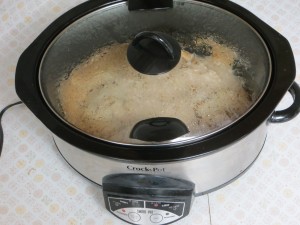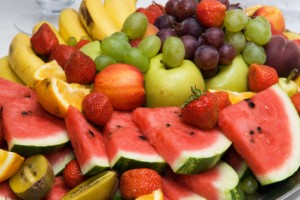by Kendra Hughson | Jan 8, 2014

Soup is a great way to pack your diet with vegetables.
Nothing tastes as good on a cold, winter day as a nice hot bowl of soup. Soups are easy to make and economical. Homemade soups are healthy. They are a great way to pack more vegetables into your diet. You can control the amount of sodium by making your own broth or white sauce or by choosing canned broth and vegetables low in sodium. Use herbs and spices for flavor instead of salt. Be creative – there are endless possible combinations of ingredients that will make a delicious soup.
Soup is easy to freeze for later use: freeze your soup in zipper style freezer bags. You can use the large bags to freeze a family size portion of soup or you can use small bags to make handy individual servings of soup. Freeze bags of soup on a plate to prevent the bags from freezing around the rack making it difficult to remove later. Run the bag under cold water until thawed enough to slip into a bowl or pot for further heating on the stove or in the microwave. You can also freeze soup in plastic or glass food grade, freezer safe containers. Be sure to leave about a half-inch of space at the top to give the soup room to expand when it freezes. Thaw in the refrigerator or run the bottom of the container under cold water until you can pop it out and place in another bowl or pot for further heating.
Here are a few common types of soup for inspiration:
Chili – the origins of chili con carne, or chili with meat, are a little mysterious and highly debated. San Antonio made this spicy dish popular more than 100 years ago. Chili consists of thick meat (pork, chicken, beef, or wild game) and/or cooked dried beans in many variations. Chili with only beans is known as chili con frijoles.
Chowder is a seafood or vegetable stew originating from New England. A New England chowder is recognized by a creamy milk base, whereas a Manhattan chowder boasts a flavorful and less fattening tomato base.
Creams and Purees consist of milk, cream, broth, and/or vegetable purees. Puree vegetables using a food processor, blender, immersion blender, or food mill. Reduce the amount of fat and calories in cream based soups by choosing lower fat alternatives like 2% milk or by using pureed white beans to thicken the soup.
Gumbo originated in southern Louisiana in the 18th century. Highly seasoned and spicy, this stew like dish blends a variety of cultures including French, Spanish, Choctaw, and West African. Gumbo is thickened with okra, file´ powder(dried and ground sassafras leaves, pronounced fee-lay), or roux (a French base made of oil and flour).
Brunswick Stew
1 tablespoon vegetable oil
1 medium chopped onion
1/2 cup chopped pepper – red, green, or a combination (optional)
2 cups chicken broth, low sodium
1/2 teaspoon dried leaf thyme
1/4 teaspoon black pepper
2 cups cooked, diced, and boned chicken or turkey
2 cups tomatoes, canned or cooked
2 cups cooked dry beans OR 1 (15.5 ounce) can beans (drained), such as red beans or Great Northern beans, etc.
2 cups whole kernel corn, frozen or 1 (15.5 ounce) can corn, canned without salt (drained)
Directions:
- Heat oil in a large pan. Add onion and cook in oil until tender.
- Add all remaining ingredients, except salt and pepper. Bring to a simmer and cook, covered, for 30 minutes on medium-low heat.
- Season to taste with salt, if desired.
Recipe Source: Adapted from Virginia Cooperative Extension
For more information on soups, contact UF IFAS Extension Leon County at 850-606-5200 or hughson@ufl.edu.
by Angela Hinkle | Sep 30, 2013

Nutty for Peanut Butter
Peanut butter is a versatile food which has soared beyond being jelly’s side kick on bread. Peanut butter can be used as a snack, as part of a full meal, in baking, and yes, even in cooking. It’s an economical source of protein and it is a wonderful food to pack on the go because it won’t spoil as quickly as most animal proteins will.
Even though most people think of them as nuts, the peanuts which are ground up to make peanut butter, are part of the legume family. Peanut butter is packed with heart-protecting mono and polyunsaturated fats – which are the “good”, cholesterol lowering fats. Also the ratio of saturated fats to unsaturated fats puts peanut butter right up there with olive oil. Do keep in mind, however, that these fats are also what make peanut butter a high calorie food. Like other yummy foods, moderation is key so try to limit yourself to about 2 tablespoons – about 180 calories.
Peanut butter is a good source of protein, and essential vitamins and minerals which include Vitamin E, niacin, and magnesium. On average, 2 tablespoons of peanut butter has about 8 grams of protein which helps contribute toward your daily protein needs and it provides energy while keeping you feeling full. Those two tablespoons of peanut butter also have about 2 grams of fiber (about 3 grams if you eat the crunchy). If you eat peanut butter with a fruit or whole grain bread, it can really boost your daily fiber intake.
For tasty ideas, look for peanut butter recipes like: yogurt peanut butter dip with fruit, Thai noodle dishes with peanut butter, peanut butter granola, and peanut butter smoothies. Peanut butter is consumed in 90 percent of households in the USA and Americans eat enough peanut butter in a year to make more than 10 billion peanut butter and jelly sandwiches. Most of us don’t outgrow our love of peanut butter. You’re never too old for peanut butter, so go nutty.
For more information about peanut butter, contact your local UF/IFAS Extension office.
by Kendra Hughson | Aug 9, 2013
Arriving home after work, the race against the clock begins. I have only two hours to get dinner on the table and to get my family fed, bathed, and in bed. But, what do I make for dinner? I need something that is quick, easy, and my family will eat.

Use a slow cooker to have dinner ready when you get home.
Preparing healthy meals at home doesn’t need to take a lot of time. Planning will go a long way to help save you time. Good nutrition doesn’t just happen; you have to plan for it. Start by creating a weekly meal calendar and shopping list. This will help you save time and money. For mealtime emergencies, keep a well-stocked pantry and plenty of frozen fruits and vegetable on hand in the freezer.
- Choose foods with faster cooking times: ground meat, tender cuts, chops, or fish. Vegetables and meat cut into small pieces will cook very quickly in a stir-fry. Canned and frozen vegetables make quick side dishes.
- Make extra food when you have time. On weekends, make double or triple batches to stock your freezer with main dishes. Soups, sauces, and casseroles work well to freeze for later use. Cook dried beans, meat, and pasta to freeze for use in meals during the week.
- One-dish meals like fajitas, salads, sandwiches, and casseroles are a great way to include a variety of nutritious foods at dinner time. Use a slow cooker to have dinner ready when you get home. One-dish meals save time on clean-up, too.
- Save time and money by incorporating “planned-overs” into your menus. Pack leftovers for lunches the next day. Use leftover chicken in salads, soups, quesadillas, or pasta dishes.
Preparing healthy meals may take some planning and effort but can be quick and easy. Now, if I could just figure out what to do about my picky eater…
To learn more about healthy cooking, sign up for the Fabulous Foods cooking series beginning in August. For more information about the cooking class or making healthy meals, contact the UF/IFAS Leon County Extension office at 850-606-5200 or contact Kendra Zamojski at Hughson@ufl.edu
_________________________________
Create Your Own Casserole or One-Dish Meal:
It is easy to make a casserole or one-dish meal with items that you have on hand. Choose one or more ingredient(s) from each of the following categories:
- 1½ to 2 cups cooked or canned meat, chicken, fish, eggs, dried beans, peas
- 1½ cups vegetables (e.g. tomatoes, green beans, potatoes, broccoli, peas, cabbage)
- 1 to 1½ cups cubed bread, cooked rice, or pasta
- 1 to 1½ cups liquid ingredients (e.g. cream soup, tomato soup or sauce, cheese sauce, white sauce, evaporated milk, or shredded cheese plus milk)
- Other optional ingredients for flavor (e.g. onion, spices, herbs)
Mix ingredients thoroughly and cook in the oven or on the stove top. If you cook in the oven, place the ingredients in a covered casserole dish and add optional toppings, such as bread crumbs, cracker crumbs, or Parmesan cheese. Bake at 350°F for 45 minutes. Uncover the last 15 minutes to brown the topping. Serve hot.
If you cook this one-dish meal on the stove top, place the ingredients in a large skillet. Simmer until bubbly. An optional topping of Parmesan cheese or croutons can be added to each serving. Serve hot.
by Angela Hinkle | May 28, 2013

Fruit – sweet, refreshing, and good for you!
As the days get warmer, bring on the cool refreshment of fruit. Now is the time to delight in fruit’s tasty, healthy goodness.
Reduce Risk and Protect
A healthy diet that is rich in fruits may reduce risk for heart disease, type 2 diabetes, and obesity, and may protect against certain types of cancers.
Healthy Nutrients
Nature brings most fruit to us low in fat, sodium, and calories, and always with zero cholesterol. Fruits are a great source of many essential nutrients and most of us don’t get enough. These include:
- Dietary fiber – helps to reduce blood cholesterol levels, is important for maintaining proper bowel function, helps reduce constipation, and provides a feeling of fullness without too many calories.
- Potassium – helps to maintain healthy blood pressure.
- Vitamin C – important for repairing all body tissues, healing cuts and wounds, and keeping teeth and gums healthy.
- Folate (folic acid) – helps the body form red blood cells and reduces the risk of neural tube defects during fetal development.
The USDA MyPlate recommends making half your plate fruits and vegetables. http://www.choosemyplate.gov
How Can You and Your Family Eat More Fruit?
- For snacks, wash whatever fruits you have on hand and place them in a big attractive bowl or basket on your table or desk. When you go by, you can grab one and start munching on it.
- Make fruit more fun and interesting by cutting it up and making it into a colorful fruit salad.
- Add fresh, frozen, or canned fruit to a smoothie or shake. Add fruit to drinks like tea and lemonade. Add some fruit to your water for a little kick of taste.
- Make a habit of using fruit as a plate garnish for breakfast, lunch, and dinner.
- Add a variety of fruit chunks to bamboo skewers or craft sticks for kabobs.
- Fruit added to yogurt provides more color, flavor, and nutrition.
- Since dried fruits last a long time, you can store a package in your car, desk, or even your pockets for a quick pick-me-up.
Sweet, refreshing, good for you fruit – now is the time to savor and enjoy.
For more information, contact your UF/IFAS county extension office.
by Heidi Copeland | May 15, 2013
 One of the most comforting memories of childhood has to be the smell of homemade yeast bread wafting throughout the house! Baking yeast bread, like many other kitchen traditions is making a comeback. Bread is a wonderful source of carbohydrades, especially if the flour is made from whole grains. (These kernels consist of three parts: the bran, the embryo and the endosperm). Eating breads made with whole grain flour can help you Make Half Your Grains Whole, as the dietary guidelines recommend.
One of the most comforting memories of childhood has to be the smell of homemade yeast bread wafting throughout the house! Baking yeast bread, like many other kitchen traditions is making a comeback. Bread is a wonderful source of carbohydrades, especially if the flour is made from whole grains. (These kernels consist of three parts: the bran, the embryo and the endosperm). Eating breads made with whole grain flour can help you Make Half Your Grains Whole, as the dietary guidelines recommend.
However, the traditional yeast bread making method – proof yeast, knead dough, rise, punch down, rest, form, rise again, and bake….is being debunked!
I’ve been experimenting with many of the recipes in Artisan Bread in Five Minutes a Day and Healthy Bread in Five Minutes a Day mostly to find a simple experience for baking yeast breads with children during 4-H summer camps. However, my experiments have been so successful that I have asked permission from Publicity @St. Martin’s Press to actually publish the master recipe as long as I give credit where credit is due.
There are those out there, myself included, that swear by the discovery of Jeff Hertzberg, M.D., and Zoë Francois that Artisan Bread can indeed be made in just five minutes of “active effort” every day.
The aforementioned authors published their first book in 2007. Currently, they have three best-selling cookbooks on the market, all of which are a very practical guide to producing delicious artisan bread and bread products that require a minimal of basic ingredients: flour, water, yeast and salt. The equipment is nominal too: measuring cups and spoons, a large storage container with a lid, a sturdy mixing tool and of course sheets or pans and an oven to bake your bread in. Of course there are other gadgets but none as necessary as what is listed.
Specifically, the authors choose the French boule (“boule” in French means “ball”) as the basic model for bread making as the shape is easy to form, the taste delicious and quite nutritious.
If you are interested in giving this process a try you can find the recipe in its entirety by clicking here Master Bread Recipe.





